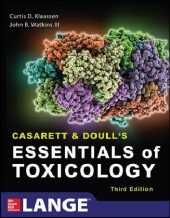 Neuerscheinungen 2015Stand: 2020-02-01 |
Schnellsuche
ISBN/Stichwort/Autor
|
Herderstraße 10
10625 Berlin
Tel.: 030 315 714 16
Fax 030 315 714 14
info@buchspektrum.de |

Curtis D. Klaassen, John B. Watkins
(Beteiligte)
Casarett & Doullīs Essentials of Toxicology
3rd rev. ed. 2015. 544 p. 277 mm
Verlag/Jahr: MCGRAW-HILL PROFESSIONAL 2015
ISBN: 0-07-184708-1 (0071847081)
Neue ISBN: 978-0-07-184708-7 (9780071847087)
Preis und Lieferzeit: Bitte klicken
Understand the essential principles of toxicology and how poisons affect the human body with this accessible and engaging summary
General Principles of Toxicology
Disposition of Toxicants
Nonorgan-directed Toxicity
Target Organ Toxicity
Toxic Agents
Environmental Toxicology
Applications of Toxicology
Casarett & Doullīs Essentials of Toxicology is an easy-to-absorb distillation of the major principles and concepts that were presented in depth in Casarett & Doullīs Toxicology: The Basic Science of Poisons, Eighth Edition , the fieldīs gold-standard text.
Presented in full color, the book concisely describes the science of toxicology, and includes important concepts from anatomy, physiology, and biochemistry to facilitate the understanding of the principles and mechanisms of toxicant action on specific organ systems. A summary of key points at the beginning and review questions at the end of each chapter help you study, understand, and memorize the material.
Reflecting the expertise of more than sixty renowned contributors, Casarett & Doullīs Essentials of Toxicology is logically divided into seven sections:
Succinct and comprehensive, there is no better text for gaining an understanding of essential principles, toxicokinetics, how toxic effects are passed on to succeeding generations, how each body system responds to poisons, and the specific effects of a wide range of toxic agents than Casarett & Doullīs Essentials of Toxicology .
UNIT 1
GENERAL PRINCIPLES OF TOXICOLOGY
1. History and Scope of Toxicology
2. Principles of Toxicology
3. Mechanisms of Toxicity
4. Risk Assessment
UNIT 2
DISPOSITION OF TOXICANTS
5. Absorption, Distribution,
and Excretion of Toxicants
6. Biotransformation of Xenobiotics
7. Toxicokinetics
UNIT 3
NONORGAN-DIRECTED
TOXICITY
8. Chemical Carcinogenesis
9. Genetic Toxicology
10. Developmental Toxicology
UNIT 4
TARGET ORGAN TOXICITY
11. Toxic Responses of the Blood
12. Toxic Responses of the Immune System
13. Toxic Responses of the Liver
14. Toxic Responses of the Kidney
15. Toxic Responses of the Respiratory System
16. Toxic Responses of the Nervous System
17. Toxic Responses of the Ocular
and Visual System
18. Toxic Responses of the Heart
and Vascular System
19. Toxic Responses of the Skin
20. Toxic Responses of the Reproductive System
21. Toxic Responses of the Endocrine System
UNIT 5
TOXIC AGENTS
22. Toxic Effects of Pesticides
23. Toxic Effects of Metals
24. Toxic Effects of Solvents and Vapors
25. Toxic Effects of Radiation
26. Toxic Effects of Terrestrial Animal
27. Toxic Effects of Plants, Fungi, and Algae
UNIT 6
ENVIRONMENTAL TOXICOLOGY
28. Air Pollution
29. Ecotoxicology
UNIT 7
APPLICATIONS OF TOXICOLOGY
30. Food Toxicology
31. Analytic/Forensic Toxicology
32. Clinical Toxicology
33. Occupational Toxicology
Curtis D. Klaassen, Ph.D., is Professor of Pharmacology, Toxicology, and Therapeutics at the Unviersity of Kansas Medical Center, Kansas City, KS.
John B. Watkins, PhD, Professor of Pharmacology and Toxicology, Medical Sciences Program, Indiana University School of Medicine, Bloomington, Indiana
Curtis Klaassen PhD Professor and Chair, Department of Pharmacology, Toxicology and Therapeutics, University of Kansas Medical Center.
John Watkins, III PhD Professor of Pharmacology and Toxicology, The Medical Sciences Program.


